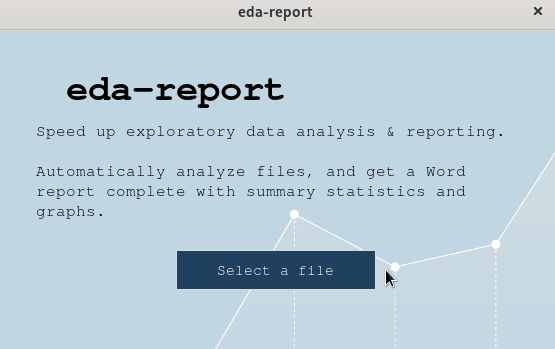A simple program to automate exploratory data analysis and reporting.
Project description
eda-report - Automated Exploratory Data Analysis
A Python program to help automate the exploratory data analysis and reporting process.
Input data is processed and analysed using pandas' built-in methods, and graphs are plotted using matplotlib & seaborn. The results are then nicely packaged as a Word (.docx) document using python-docx.
Installation
You can install the package from PyPI using:
pip install eda-report
Basic Usage
1. Graphical User Interface
The eda-report command launches a graphical window to help select and analyse a csv/excel file:
eda-report
You will be prompted to set a report title, target variable (optional), graph color and output filename, after which the contents of the input file will be analysed, and the results will be saved in a Word (.docx) document.
NOTE: For help with
Tk- related issues, consider visiting TkDocs.
2. Command Line Interface
To analyse a file named input.csv, just supply its path to the eda-report command:
eda-report -i input.csv
Or even:
eda-report -i input.csv -o output.docx -c cyan --title 'EDA Report'
For more details on the optional arguments, pass the -h or --help flag to view the help message:
eda-report -h
usage: eda-report [-h] [-i INFILE] [-o OUTFILE] [-t TITLE] [-c COLOR]
[-T TARGET]
Automatically analyse data and generate reports. A graphical user interface
will be launched if none of the optional arguments is specified.
optional arguments:
-h, --help show this help message and exit
-i INFILE, --infile INFILE
A .csv or .xlsx file to analyse.
-o OUTFILE, --outfile OUTFILE
The output name for analysis results (default: eda-
report.docx)
-t TITLE, --title TITLE
The top level heading for the report (default:
Exploratory Data Analysis Report)
-c COLOR, --color COLOR
The color to apply to graphs (default: cyan)
-T TARGET, --target TARGET
The target variable (dependent feature), used to
color-code plotted values. An integer value is treated
as a column index, whereas a string is treated as a
column label.
3. Interactive Mode
3.1 Analyse data
>>> import eda_report
>>> from seaborn import load_dataset
>>> iris_data = load_dataset("iris")
>>> eda_report.summarize(iris_data)
OVERVIEW
========
Numeric features: sepal_length, sepal_width, petal_length, petal_width
Categorical features: species
***
Summary Statistics (Numeric features)
-------------------------------------
count mean std min 25% 50% 75% max skewness kurtosis
sepal_length 150.0 5.8433 0.8281 4.3 5.1 5.80 6.4 7.9 0.3149 -0.5521
sepal_width 150.0 3.0573 0.4359 2.0 2.8 3.00 3.3 4.4 0.3190 0.2282
petal_length 150.0 3.7580 1.7653 1.0 1.6 4.35 5.1 6.9 -0.2749 -1.4021
petal_width 150.0 1.1993 0.7622 0.1 0.3 1.30 1.8 2.5 -0.1030 -1.3406
***
Summary Statistics (Categorical features)
-----------------------------------------
count unique top freq relative freq
species 150 3 setosa 50 33.33%
***
Bivariate Analysis (Correlation)
--------------------------------
sepal_length & petal_width --> strong positive correlation (0.82)
sepal_length & petal_length --> strong positive correlation (0.87)
petal_length & petal_width --> very strong positive correlation (0.96)
sepal_length & sepal_width --> very weak negative correlation (-0.12)
sepal_width & petal_width --> weak negative correlation (-0.37)
sepal_width & petal_length --> weak negative correlation (-0.43)
3.2 Generate a report
>>> eda_report.get_word_report(iris_data)
Bivariate analysis: 100%|███████████████████████████████████| 6/6 numeric pairs.
Univariate analysis: 100%|███████████████████████████████████| 5/5 features.
[INFO 17:31:37.880] Done. Results saved as 'eda-report.docx'
<eda_report.document.ReportDocument object at 0x7f3040c9bcd0>
Visit the official documentation for more details.
Project details
Release history Release notifications | RSS feed
Download files
Download the file for your platform. If you're not sure which to choose, learn more about installing packages.
Source Distribution
Built Distribution
Hashes for eda_report-2.4.0-py3-none-any.whl
| Algorithm | Hash digest | |
|---|---|---|
| SHA256 | a2e88f060285e13ec3fbfa8a60bba1afc063274448b20deba94df24e08f43ce4 |
|
| MD5 | d1659a7a23e1e00ab83f4eb576ec8301 |
|
| BLAKE2b-256 | bb66299a0f00f67e0a1890d584c536e95af9e5e759445e5b9491aaa1dc556a73 |


















